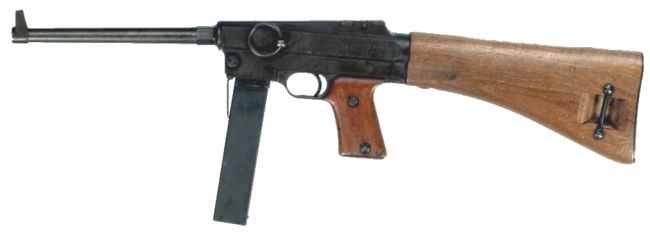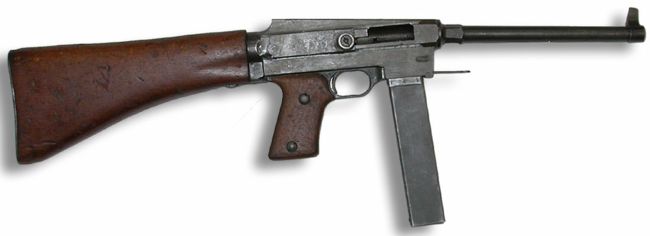
MAS-38 submachine gun, left side.

MAS-38 submachine gun, right side.
| Caliber | 7,65x20mm Longue |
| Weight | 2,83 kg empty |
| Length | 635 mm |
| Barrel length | 222 mm |
| Rate of fire | 600 rounds per minute |
| Magazine capacity | 32 rounds |
| Effective range | 50-100 meters |
The MAS-38 (MAS Mle 1938) submachine gun was developed by French state arsenal in St.Etienn (Manufacture d'Armes de Saint-Etienne or MAS in short). Development of a new submachine gun for French army commenced at several state armories during early 1930s; in about 1935 MAS produced a prototype weapon known as SE-MAS 1935, which by 1938 evolved into MAS-38. It was officially adopted by French government in 1938 and production started in 1939, but only few were in service when Germany took over France in 1940. MAS-38 saw limited use during the World War 2, and soon after the war it was replaced in military service with more powerful MAT-49 submachine gun, although few MAS-38 saw the action i the early stages of the Indochina war. In police service, on the other hand, MAS-38 survived during at least for two more decades.
Generally speaking, MAS-38 was quite good weapon, reliable and rather accurate and controllable; its only problem was underpowered 7,65×20 Long ammunition, which greatly limited is effective range.
MAS-38 submachine gun was blowback operated, full automatic only weapon that fired from open bolt. The most unusual thing about MAS-38 was that bolt rode at a slight downward angle to the axis of the bore; in theory, this was done to reduce recoil and slow down the movement of the bolt by additional friction. The bolt reciprocated inside the long tube, that run through the wooden buttstock. The cocking handle was located on the right side of the gun and had a dustcover attached to it. Once gun was cocked, the cocking handle remained in retracted position and not reciprocated when gun was fired. Additional dustcover was fitted to the front of the magazine housing, and closed magazine aperture when magazine was removed. The manual safety was made in the form of folding trigger; to render the gun safe operator had to fold the trigger forward. Standard sights consisted of front blade and two folding rear blades.